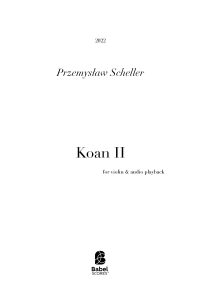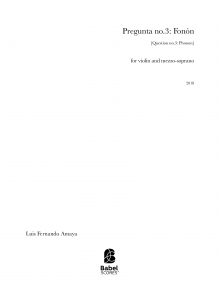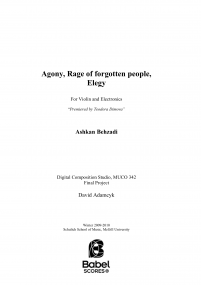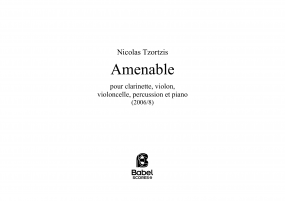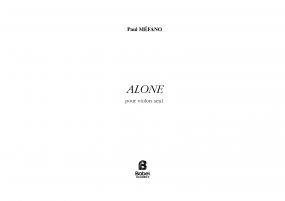Recherche avancée
Dance Suite
ISMN : 979-0-2325-6514-9
- Identifiez-vous pour créer une liste
Program Notes:
"This piece is the first in a series of upcoming works exploring the translation, or transliteration, of movement concepts from Ohad Naharin's Gaga dance language into musical and sonic aesthetic forms. I've been interested in Gaga, which is explicated further on a following page, for quite some time, but in the past year it
has become a true necessity for me. Gaga has a fundamentally healing quality to it, in that it exists in the fissured space between the mind and the body. For example, I was in a car accident last September in which I suffered a traumatic brain injury, and Gaga class is sometimes the only space in which my physical pain and symptoms abate.
The piece comprises five movements (described below) which each excise particular linguistic concepts and tenets from Gaga, and explore them along a violinistic pathway reminiscent of 17th century dance suites. Each one contains the foundational concept of "describing curves and overlapping circles in interior and
exterior space", which is one of the defaults in Gaga.
Movement I: composed; meditative
-negating gravity on a molecular level
-floating to grabbing through letting go
-the pleasure of speed
Movement II: improvised with prerecorded audio of text; absurd
-traveling textures
-the virtue of lightness
-connecting to the groove and silliness
-connecting to a fantasy of ___ (ballerina, toreador, tap dancer, fencer, gymnast, martial artist, etc.)
-the beginnings of a secret smile/smiling throughout your flesh
Movement III: composed; grieving
-sensing the distance between things
-dead flesh vs. igniting distant engines
-shaking vs. quaking
-surrendering to your tiredness
-blocking the flow vs. connecting to the flow of energy
Movement IV: improvised with prerecorded audio of text; parxoysmic
-the availability for rotating (ball) movement in our joints and to change our minds
-finding the groove through weakness
-moving vs. being moved
-getting rid of your skin/shaking off the unwanted
-moving larger and smaller at the same speed vs. changing speed in order to change size
Movement V: composed; celebrator y (dance party!)
-plenty of time/piece of cake in the effort
-collapsing into movement by letting go
-the pleasure of stretch
-the passion to move
-being decorated from the inside/delicacy
-overwhelming the senses with tasks
-the beautiful spirit
I tried to be highly specific with these selections, and each movement reverse-engineers the resultant sound from the physical concepts of Gaga, on different levels of explicitude. Some movements function as a guided improvisation focusing on internal sensation of the distance and form of the body in space, exactly like a Gaga technique class, and others are abstract or programmatic musical depictions of linguistic concepts developed by Ohad Naharin ("floating the bone in the flesh", etc.). The goal was to derive sound from movement, beginning with the action of motion itself and seeing the sound as a result rather than the directive, accomplished through the conduit of the instrument as an extension of the body.
Two other traditions informed the praxis of this piece: analog filters applied to traditional and popular Jewish folk music, and obligator y idioms of the virtuoso violin repertoire. For example, the pitches and pitch classes of the three notated movements are derived from three folk songs from the diaspora, respectively:
Abi Gezunt (If you have your health...) (Yiddish, secular, 1930s)
Echad Mi Yodea (Who knows one?) (Hebrew, religious, 15th century)
Ale Brider (All brothers) (Yiddish, secular/pro-labor, 1920s)
And the gestures themselves are derived from the canonical solo repertoire, such as large leaps, down/upbow, staccato, large intervals such as tenths and above, bariolage bowing, trills and ornamentation, perpetual motion, etc.
This all relates to the theme of the This Is America project in several ways. First, Gaga was a retreat and a salvation for many across the globe in 2020, from professionals unable to rehearse and first-time dancers who were lonely
by themselves at home, and it became a visceral release in a time of being emotionally and physically shut in, trapped, suspicious, guarded, and frightened.
Second, Gaga's maxims are inherently liberating; they are scriptural without being dogmatic. One can practice Gaga as a spirtual endeavor without needing to lose one's curiosity, dubiousness, or skepticism. It is a science and a philosophy and a theology all at once. One doesn't have to be trained as an improviser in order to understand and internalize Gaga. The only prerequisite is that you abandon your preconceptions, your judgements, and your inhibitions, and commit yourself fully to the idea, to yourself, to the moment, and to each other. This just might be
the mentality that ultimately will save our broken society and our dying planet, in my opinion.
Third, Johnny's and my Jewish ancestry and the presence of dance and dancers in our lives provoked a sense of relevance to the impossibly optimistic Ashkenazi maxim that "if you have your health, you can be happy", which is present in the healing, celebrator y, and communal side of Gaga.
Last of all, I want to conclude these notes with an image from the final scene of Bela Tarr's film Damnation (Karhozat):
https://www.youtube.com/watch?v=feaIhmmMDAw
In this scene, about which I've been thinking a lot during the pandemic, the cyclical chaos of the rain, the desperate pacing of the starving dog, and the tired steps of the damned man are a kind of counterpoint that devastates the soul by providing it a mirror. The sequence is so uncanny because it is alien and familiar at the same time. As we navigate this postmodern world in which death is preventable yet disregarded, I think the key, especially for thinking Americans, is to always keep alive the sensation that the world is uncanny, strange, and horrifying. When
we become desensitized to darkness, we damn our own souls and our futures.
Simultaneously, the absurd in the self's smallness and insignificance is to be celebrated, as Gaga requests, with total commitment and without taking oneself too seriously.
-Maya Miro Johnson
June 15th, 2021"
Pages - 28




